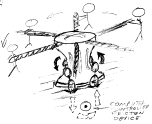EDTEC 671: Learning Environment Design
Informal Learning Exhibit Technology
The New London Sea Chantey Museum
Informal Learning Environment ~ Technology
(Download: 534kb .doc)
Exhibit/Display Technology
The Sea Chantey Museum will employ various educational technology, spanning the complete range of low to high tech. Descriptions of planned technology are broken down by activity area.
Exhibit-wide (all areas)
These techniques will be used throughout the museum.
Technique |
Comments |
Ambient lighting |
The exhibit lighting will change slowly over the period of 90 minutes. Night will fall for 15 minutes each “day”, allowing the staff to program chantey sings and demonstrations around the natural rhythm of a day at sea. Every third “day” will feature an afternoon storm, complete with gloomy grey overcast, flashes of (muted) lightning, and swirling clouds projected on the screens. |
Audio |
The sea chantey experience will be enhanced by ambient noises from a sailing ship at sea, including creaks and clanks, the sound of seagulls, and of waves slapping the bow. Periods of simulated storm will also feature (muted) thunder and increased wave activity.For some chantey presentations, instrumental accompaniment will be available to the staff (in case they are accomplished vocalists but not instrumentalists). |
Bow area (high energy activities)
Technique |
Comments |
Live “Chanteymen” |
The exhibit “characters” will lead competitive activities and chantey singing. In addition to explaining the process, they will also add “atmosphere” with authentic costumes and mannerisms. |
Hands-on displays |
Two interactive simulators will be employed to get visitors involved with an authentic chantey experience. The first will be a circular or pump capstan simulation. The second will be dual sail halyard simulation.
The live guides can use the two simulators to demonstrate how different sea chanteys were used for different tasks at sea. The halyard simulators can be used by one group, two groups in competition, or for demonstration by the staff in the event no visitors wish to participate. |
Rear-projection screens |
The capstan simulator will present a view of the water below. Participants will be able to see a video presentation of the anchor coming to the surface, rising clear, and coming aboard. Each halyard simulator will be tied to a video presentation of a staysail being hoisted aloft. For both simulators, the video speed will be coordinated with the speed of the participants at the hands-on apparatus. |
Waist area (medium energy activities)
The waist will display small artifacts, contain kiosks supporting individual interaction, and have an area dedicated to live demonstrations.
Technique |
Comments |
Interpretive audio kiosks |
A series of 6 audio kiosks will line the starboard rail. Each kiosk will be equipped with ruggedized headphones, with additional headphone jacks so visitors can use their own equipment. The kiosk will be activated by touch screen. Audio will revert to 25% at the start of each program, adjustable to a maximum of 85dB. |
Replica instruments and sailing equipment |
Several curved benches and leaning rails with display cases built in will contain small instruments such as harmonicas, spoons, and tin whistles. Each artifact will be accompanied by a small descriptive sign.
Museum staff will be available to demonstrate how certain instruments were used to support various sea chanteys, and allow visitors to manipulate replica objects. |
Podcasts |
Each singalong will be recorded and given a unique code. Visitors returning to the museum web site later can enter the code to download their own recording. All visitors’ recordings will be online, along with “expert” examples. |
Parabolic speakers |
Four stations (two flanking both the foremast and mainmast) equipped with overhead parabolic speakers will offer a small group interactive experience, free of headphones. Small groups will be able to gather under the speakers to listen, without interfering with the experience of other visitors.
These displays will demonstrate the musical difference between halyard chanteys, capstan chanteys, and forecastle songs. The exhibits will also tie in modern music, and draw attention to the live activities taking place in the bow area. |
Stern area (low energy activities)
The stern is the “quiet” exhibit area. Visitors to this area will have access to large displays describing the history of sea chanteys, the influence of cultural and ethnic forces on sea chantey lyrics, and the impact of ocean-going folk music on the landscape of modern popular music. This area is also the lobby for the auditorium, where people will wait (and learn) before live performances.
Technique |
Comments |
Timeline display |
A collage of images underlying a timeline showing chronological events from the age of sail. This display can cover the entire wall area. It will be curved to overhang visitors and allow viewing from the other side of the exhibit. The timeline itself will have the most prominent font, and will be positioned at about 1.5m height. |
Music display |
The musical influence display will contain sheet music in flip binders, biographies of famous historical chanteymen (and some of modern practitioners), and descriptions of how some lyrics changed over time (with examples). This display will be no more than 1.5m tall, to allow access by children and also not block the view of the rest of the museum. |
Social display |
This area will help interpret sea chantey lyrics within the social context of the 1800s. The interplay between ethnic groups in the “at sea melting pot” will be a large component of this display. Visitors will be able to read about what each group brought to the mix of sounds, and how the meaning of certain lyrics has been obscured by time. |
Library |
Locked glass-front library cabinets will contain printed music, histories, and biographies. Library material will be available to select researchers by appointment before and after normal museum hours. Some printed volumes will be available in the gift shop. |
Additional Information
http://en.wikipedia.org/wiki/New_London%2C_Connecticut
http://en.wikipedia.org/wiki/Sea_shanty




